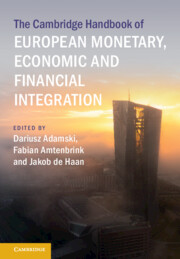Book contents
- The Cambridge Handbook of European Monetary, Economic and Financial Integration
- The Cambridge Handbook of European Monetary, Economic and Financial Integration
- Copyright page
- Contents
- Contributors
- Introduction
- Part I The Economic and Monetary Union
- Part II The Monetary Dimension
- Part III The Economic and Fiscal Dimensions
- 15 Reviving the Case for Policy Coordination in EMU
- 16 Ten Years of the European Semester
- 17 The EU Fiscal Rules
- 18 National Fiscal Policy in EMU
- 19 The Politics of Fiscal Integration in Eurozone Reforms and Next Generation EU
- 20 Adjustments in Economic Crises
- 21 Designing a Permanent EU-Wide Stabilization Facility
- 22 Enhancing Private and Public Risk Sharing
- Part IV Financial Integration
- Index
- References
22 - Enhancing Private and Public Risk Sharing
Lessons from the Literature and Reflections on the COVID-19 Crisis
from Part III - The Economic and Fiscal Dimensions
Published online by Cambridge University Press: 28 September 2023
- The Cambridge Handbook of European Monetary, Economic and Financial Integration
- The Cambridge Handbook of European Monetary, Economic and Financial Integration
- Copyright page
- Contents
- Contributors
- Introduction
- Part I The Economic and Monetary Union
- Part II The Monetary Dimension
- Part III The Economic and Fiscal Dimensions
- 15 Reviving the Case for Policy Coordination in EMU
- 16 Ten Years of the European Semester
- 17 The EU Fiscal Rules
- 18 National Fiscal Policy in EMU
- 19 The Politics of Fiscal Integration in Eurozone Reforms and Next Generation EU
- 20 Adjustments in Economic Crises
- 21 Designing a Permanent EU-Wide Stabilization Facility
- 22 Enhancing Private and Public Risk Sharing
- Part IV Financial Integration
- Index
- References
Summary
The chapter surveys the literature on consumption risk sharing, focusing on the findings for the euro area and for the United States, but also presenting evidence for other countries. The literature examined found that risk sharing is higher in more mature federations, such as the United States, than in the euro area. The studies surveyed suggest that state/country-specific output shocks are primarily smoothed out through the capital and credit channel, whereas the fiscal channel as a minor role, especially in the euro area. Overall, about 70 per cent of shocks are smoothed in the United States while the figure is just 40 per cent in the euro area. At the same time, analysis of the response to the COVID-19 crisis indicates that risk sharing in the euro area has been more resilient than it was during the Global Financial Crisis of 2008–9. Overall, the results point to the need for further improvements to the private and public risk-sharing channels in the euro area to ensure more effective cushioning against asymmetric shocks and to boost progress towards the completion of European Monetary Union.
- Type
- Chapter
- Information
- Publisher: Cambridge University PressPrint publication year: 2023



